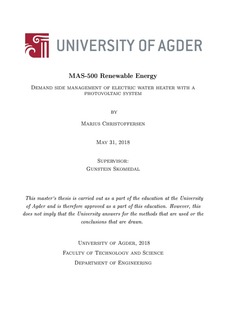| dc.description.abstract | This thesis presents the development of a load controller, which can be used to store self-
produced electricity as hot water in a regular electrical water tank. The electricity market today
facing challenges towards grid utilisation and consumption during peak hours. To prevent massive
investment for the grid operators for upgrading the grid to handle peak hours, a better utilisation is
necessary. An expected increase in electricity prices together with a reduction of cost for renewable
energy production opens for new solutions to reduce the grid electricity consumption. The problem
statement was to design a controller for implementation on a regular electric water heater in a
household, with the aim to reduce the grid peaks, and the price of hot water in the household, by
increasing the temperature when there was excess electricity available from the photovoltaic sys-
tem. By using an already existing household appliance, the investment cost of the overall system
compared to, i.e. batteries are low. Previous research has focused towards reducing grid consump-
tion during peak hours from a grid operators point of view, and the approach was to use models
to predict the water consumption and remotely control the heater. However, recent research has
included demand-side management and more precise models. In the thesis, the controller is used
for demand-side management, and only require a few modi cations to the electric water heater.
For estimating water consumption, two pro les are used which is based on average and electricity
based water consumption. The controller uses logic and forecast data to set the tank temperature
according to expected PV production. During testing, some improvements were made to optimise
the controller, but for further increasing the energy storage and cost reduction, additional improve-
ments are necessary. The results show that energy storage would reduce the grid consumption, and
reduce the price of electricity between 9-55% per day with grid tari , depending on the amount
of self-produced electricity. However, more experiments and with other water usages is required
to con rm the saving potential for grid consumption. Besides, the consumption in high demand
periods is reduced by shift the demand from the Electric Water Heater(EWH). This can be further
improved by power control of the heating element in the EWH as the results show that without
power control, the savings results are inconclusive. Overall, the controller reduces the peaks in the
grid and lowers the cost of hot water, but the exact saving is not possible to predict until the new
electricity prices structures are available. Nevertheless, the results show that there is possible to
store large amounts of energy as hot water, without a ecting the user-comfort, with the bene ts of
reducing grid consumption and peaks. | nb_NO |

